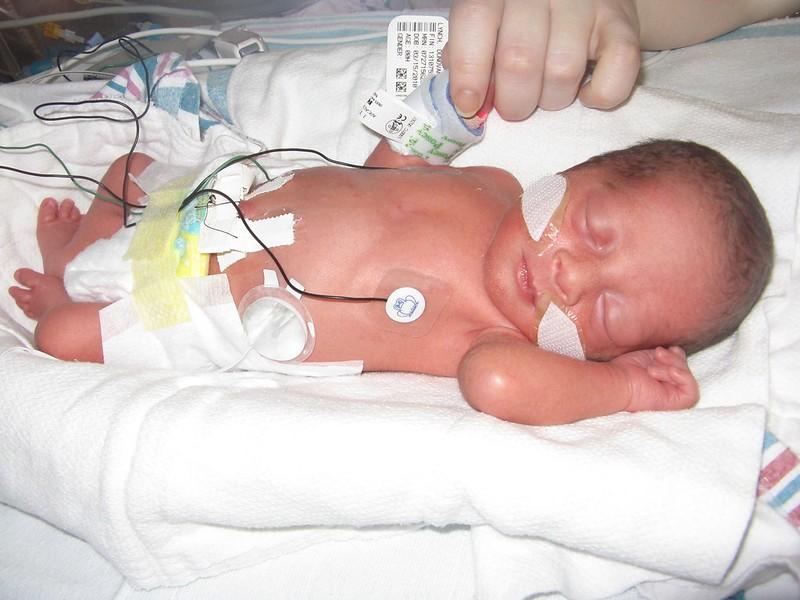Two new US studies have identified an elevated risk of preterm birth and severe COVID-19 illness in pregnant women, while a systematic review and meta-analysis of maternal and neonatal outcomes found that the novel coronavirus doesn't seem to significantly influence pregnancy.
Half of virus-positive infants born preterm
The first of the two studies, both published yesterday in Morbidity and Mortality Weekly Report (MMWR), monitored birth and infant outcomes in 4,442 pregnant women infected with the coronavirus and their 4,527 fetuses and newborns from Mar 29 to Oct 14 in 16 Surveillance for Emerging Threats to Mothers and Babies Network (SET-NET) jurisdictions.
Of the 3,912 infants with known gestational age born to pregnant women with COVID-19, 12.9% were born preterm (before 37 weeks gestation), compared with an estimated national rate of 10.2%. Of the 610 newborns with coronavirus test results, only 2.6% were positive, most of them born to women with active infections at delivery.
Of the 4,527 fetuses and newborns, 4,495 were live births, including 79 sets of twins and one set of triplets, and 32 were miscarriages 12 of them (0.3%) at less than 20 weeks' gestation and 20 (0.4%) at 20 weeks' or longer gestation. Of 3,486 live births with weight, gestational age, and sex recorded (77.6%), 198 (5.7%) were small for gestational age. Nine of 4,495 infants (0.2%) died in the hospital.
Eight of 16 infants who were positive for COVID-19 (50%) were born pre-term, all of whom required intensive care unit (ICU) admission, although the indications were not documented. Of the eight infants born at term who had positive test results, one was admitted to the ICU because of fever and the need for extra oxygen.
Median maternal age was 28.9 years, and 46.0% were Hispanic or Latina. At least one underlying illness was noted for 1,564 women (45.1%), the most common of which was prepregnancy obesity (35.1%). The vast majority of women's infections (84.4%) were diagnosed in the third semester. Of the 2,691 women with known symptom status (60.6%), 374 (14.0%) reported no symptoms.
The authors said that because most infected pregnant women reported to date were infected in the third trimester, ongoing monitoring is needed to evaluate the effects of infection in early pregnancy and the long-term outcomes of exposed newborns.
In the meantime, pregnant women should be counseled on the risks of coronavirus infection, they said. "Pregnant women and their household members should follow recommended infection prevention measures, including wearing a mask, social distancing, and frequent handwashing when going out or interacting with others or if there is a person within the household who has had exposure to COVID-19," the researchers wrote.
Higher need for intensive interventions
The second MMWR study is an update of a Jun 26 report, with the new study detailing the characteristics of 23,434 symptomatic pregnant women aged 15 to 44 years infected by COVID-19 from Jan 22 to Oct 3 in the National Notifiable Diseases Surveillance System (NNDSS). The earlier study assessed 8,207 pregnant women.
After adjusting for age, race/ethnicity, and underlying illnesses, pregnant women in yesterday's study were significantly more likely than nonpregnant women to require ICU admission (3.9% vs 1.1%; adjusted risk ratio [aRR], 3.0), mechanical ventilation (2.9% vs 1.1%; aRR, 2.9), and extracorporeal membrane oxygenation (extra oxygen added outside the body; 0.7% vs 0.3%; aRR, 2.4) and to die (1.5% vs 1.2%; aRR, 1.7).
While increased risk for ICU admission was seen in all pregnant women, it was particularly high among Asian (aRR, 6.6) and Native Hawaiian/Pacific Islanders (aRR, 3.7). Pregnant Hispanic women were at higher risk of both COVID-19 infection and death than their nonpregnant peers, and both pregnant and nonpregnant black women were at disproportionate risk of death relative to their distribution among infected women.
Compared with their non-pregnant counterparts, pregnant women aged 15 to 24 years were at three times the risk of requiring mechanical ventilation, while those aged 35 to 44 had 3.6 times the risk.
The authors said that although the absolute risks of serious outcomes for pregnant women were low, they were at increased risk for severe COVID-19 disease, possibly because of physiologic changes in pregnancy, including increased heart rate and oxygen consumption, reduced lung capacity, a shift away from cell-mediated immunity, and elevated risk of blood clots.
"To reduce the risk for severe illness and death from COVID-19, pregnant women should be counseled about the importance of seeking prompt medical care if they have symptoms, and measures to prevent [coronavirus] infection should be strongly emphasized for pregnant women and their families during all medical encounters, including prenatal care visits," the researchers said.
Review shows illness not severe in most
The meta-analysis, which included 24 studies involving 1,100 pregnancies, was published Nov 1 in Clinical Microbiology and Infection by researchers in Trieste, Italy.
Of all pregnant women in the study infected with COVID-19, 89% had pneumonia, 85% delivered via caesarean, and 8% required ICU admission. But the pooled prevalences of ICU admission and maternal death were similar to those reported in women who weren't pregnant.
Five of the 1,100 women (0.5%) died, three of 779 fetuses (0.4%) were stillborn, and three of 537 newborns (0.6%) died, none of them of causes related to COVID-19. Two percent of newborns required ICU care, and 4.3% tested positive for coronavirus.
Mean gestational age at birth was 38 weeks. The pooled prevalence of preterm delivery was 23%, which is higher than the 5% rate in the European general obstetric population. "It is unclear, however, whether COVID-19 might be the direct cause of preterm delivery; viral infection during pregnancy can induce an abnormal response to an opportunistic bacterial infection that might lead to preterm labour and delivery," the authors wrote.
Of 54 newborns with data on respiratory symptoms and oxygen support, only 1 needed extra oxygen in the form of noninvasive ventilation. Onset of coronavirus-related symptoms that required hospitalization or prolonged the hospital stay after delivery occurred more often in women before delivery (525 women [73%]) than after (462 [22%]).
The authors concluded that while ICU admission and death can occur, COVID-19 infection is not severe in most pregnant women and doesn't seem to substantially influence the pregnancy.
"A high caesarean delivery rate is reported, but there is no clinical evidence supporting this mode of delivery," the researchers wrote. "Indeed, in most cases the disease does not threaten the mother, and vertical transmission [from mother to infant] has not been clearly demonstrated. Therefore, COVID-19 should not be considered as an indication for elective caesarean section."





















